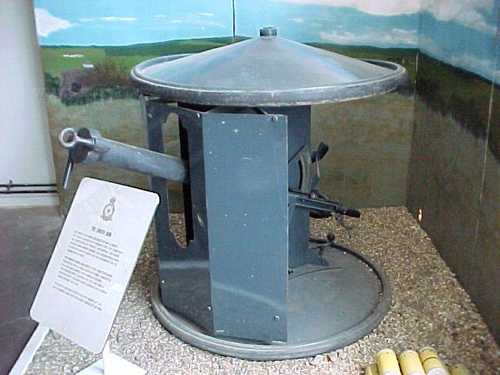
Modern/Post-War Photos
Another terrifying Home Guard weapon ...
RAF Regiment Museum, Honington
This is an example of the Smith Gun, preserved in the RAF Regiment Museum, Honington. Mr Smith - an engineer, who made his living designing a children's educational construction toy called Meccano (some of you will know it) - designed the gun as a private venture in response to the shortage of artillery in Britain following the evacuation of the BEF from Dunkirk. The War Ministry were not impressed - but Winston Churchill was. In consequence, the weapon went into production in 1941, and began to be distributed to the Home Guard and (possibly) to some Army units involved in airfield defence in late-1941. The standard Smith was of 3 inch calibre, and fired a variety of incendiary, explosive, smoke, and anti-tank grenades. It could be towed using the larg discs as wheels. When the desired location was reached, the gun was unlimbered and turned "on its side" onto the flat disc, putting it in firing position. A guard plate, mounted between the discs, provided frontal protection for the gunners and completed a sort of "half-pillbox" structure, as seen here. The Smith was really not much use. A range of 500 yards was claimed but - in practice, the gun carried effectively for little over 100 yards, and was alarmingly inaccurate. Also, it had a distressing tendency to blow up on the operators - a "terrifying reputation for killing its crew" was attributed to it by one historian of the Home Guard (I did say it was "terrifying!). This latter characteristic appears to have been down to two things. First, the fuses of the grenades supplied were often defective, with obvious results. Secondly - as befitted a gun designed by the designer of Meccano - the weapon was supplied to the receiving Home Guard units in disassembled kit form, and they often got the assembly instructions wrong. One Home Guard website tells a story of the Guards involved finding a single washer in the kit boxes after assembling the gun. Rather than going back and doing the whole thing again, they decided to ignore the washer and do a firing test. The first firing - of an incendiary grenade - was spectacular. The gun vanished in a cloud of smoke and flame, from which the two-man crew staggered. They were shocked, singed, blackened, but fortunately still alive. It subsequently emerged that the errant washer was required to prevent an unfortunate conjunction between the fuse of the grenade and a part of the gun. It appears that some Home Guards actually got to like this weapon. Perhaps Captain Mainwaring was not the only person in the Home Guard suffering from delusions ... Best regards, JR.
3844 Views
12/8/2009
